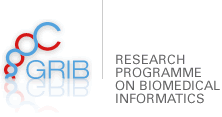
Thursday, 17th November, 2011, 11:00-12:00
Protein flexibility in docking with discrete molecular dynamics simulations
The aim of protein-protein docking is to predict how two proteins associate to form a complex. This means determining where will be the interface. This is a complex problem with many degrees of freedom. To reduce the sampling space, in general both proteins are considered to be rigid bodies (rigid docking). This reduces the problem to 6 degrees of freedom (3 for translation and 3 for rotation). The rigid body docking is a rude approach, since the proteins have flexibility and may undergo relevant conformational changes upon binding to the other protein when forming the complex. We have used discrete molecular dynamics (DMD) simulations to include the protein flexibility in docking configurations, and we have improved the predictive power of the method. DMD is a simplified molecular dynamics method much faster than standard MD, specially for systems with less that 10^3 particles.
Speaker: Dr. Agustí Emperador-Institut for Research in Biomedicine (IRB, Barcelona)
Room Seminar Room “Xipre” 173.06 (PRBB – 1st floor)


